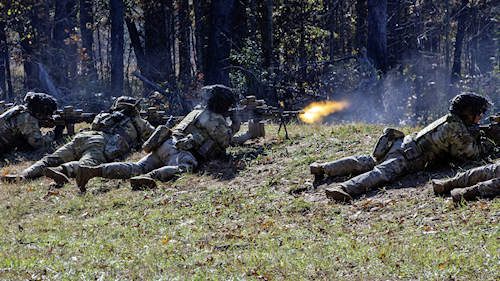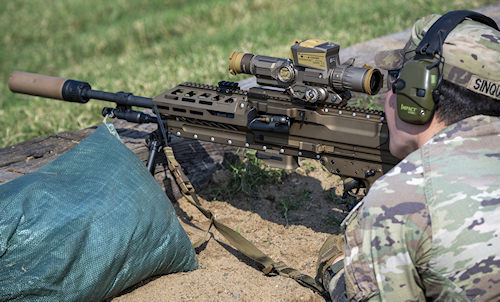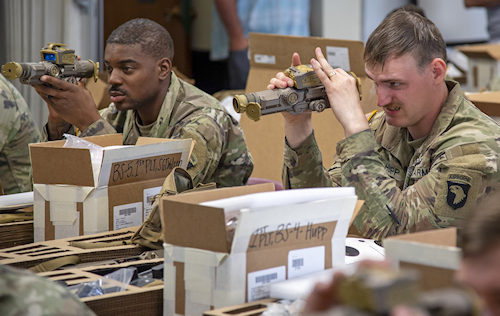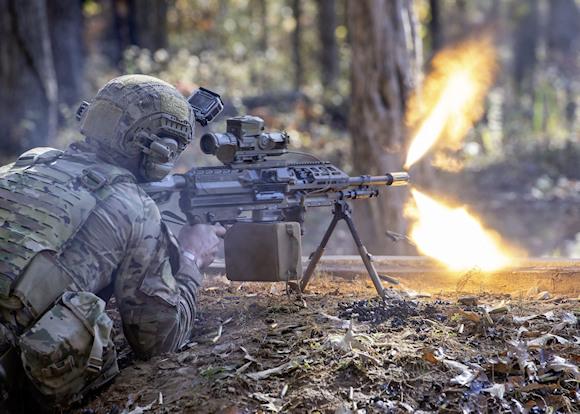The "Long March" to give a caliber to the new individual and team weapons of the US infantry and Marines (and therefore also to NATO) it is not yet finished. However, the technical-practical "mountain passes and deserts" that characterized it are certainly over.
The "Screaming Eagles" of the 101a parachute division of the US Army, some of its most representative regiments (the 502nd Infantry Regt and 75th Ranger Regiment qualified for special operations), have carried out both static and dynamic operational tests in order to verify the peculiar capabilities (and diversity) of the new caliber 6.8x43, compared to the 5.56x45 caliber currently used for both assault rifles and squad machine guns.
The NGSW (Next Generation Squad Weapons) program is subject to the acquisition authority of the OTC, the operational body independent which evaluates the army's combat systems, using operational departments to realistically verify whether they are effective and logistically supportable. The OTC is required by law to test systems before they are deployed in the field, and has American soldiers as its sole contractor.
The conventional and special operations in Iraq and Afghanistan have made clear the need, which can no longer be derogated, to be able to have new weapon systems which, while guaranteeing the engagement distances of the most performing versions of those chambered in 7.62x51 (and even better by following those of 6.5 Creedmoor, the choice of the SOCOM "marksmen), had transport practicality similar to those in 5.56x45 (30 magazines and 250/300 round belts), which, to tell the truth, the US FFAA had already realized since years of insufficient "stopping power", an ammunition which was not particularly suitable especially for team support weapons (the SAW M249) and, again, insufficient for the functions of the "marksman" of infantry platoons.

The choice went towards an already existing caliber, designed and produced for "hunting" use by Remington Arms: the 6.8 SPC.
What follows is the personal opinion of the writer, taken from some "off the records" considerations made with some US military and civilian shooters.
Sometimes Americans exceed in pragmatism, it must be said, which has historically brought them so many valid results. To simplify the acquisition procedure (and related tests) of the new caliber, apparently ideal for the purpose, it seems that some semi-automatic rifles of the AR15 type (M16-M4) with barrels chambered for the cal. were assembled pragmatically. .270, apparently theoretically suitable for use, but not specifically designed.
It was a mistake. The general performance was more than disappointing and slowed down the acquisition procedures, almost permanently.
Once this "strange" technical improvisation was removed, when the dimensional engineering of the project was reviewed in a precise and specific way, especially in relation to the expected operational use, i.e. the "military" sector in semi-automatic and automatic, the qualities of the new 6.8 x43 became evident. It was therefore possible to carry out tests with different bullets and powders, selecting the best general and specific parameters, based on the envisaged missions (which substantially vary depending on the weapon and the envisaged engagement distances), as the lengths and steps of engagement varied. rifling of the barrels and the pressures developed in the chambers.
 Last but not least, also based on new safety and health protection regulations for soldiers, the noise emissions of ammunition were also evaluated, with and without suppressors (topic recently addressed here), and the results appear to be excellent.
Last but not least, also based on new safety and health protection regulations for soldiers, the noise emissions of ammunition were also evaluated, with and without suppressors (topic recently addressed here), and the results appear to be excellent.
The data obtained by observing the exercises of 101a airborne division they speak of "Over the Expectations" in all contexts, which, given the vast operational experience (to put it mildly), I would tend to trust, while hoping to do personal tests as soon as possible, especially regarding the weights of the nose cones due to the different mission, with particular interest in "marksman" shooting (up to 1000 meters), given that the NGSW program requires a cartridge that uses bullets of approximately 135 grains, with an initial velocity of approximately 3000 fps / 915 m/s, and even faster. These requirements, especially when imposed on a relatively short barrel, require very high pressures, usually generating strong recoil.
The men of 101a they describe the detection, in semi-automatic, as similar to those of the 5.56x45 of their current M4s, but with an incomparable greater energy on target. This leads me to think that the engineers did an excellent job, to say the least, on the mechanics (moving weights and masses), and the chemists on the dust.
What, in my opinion, is not underlined enough, as usual, is that a munition is part of a "weapon system", let's repeat it again, composed of rifles (or other weapons), the fire control systems (sights, optics and integrated systems) and, indeed, the cartridges. The nose cone is what will be "delivered" to the target, by the "teamwork" of these components.

The basic requirement of the system includes a variable power optic for short, medium and long range viewing, an integrated rangefinder, a ballistic calculator and a digital display capable of providing an adjusted aiming point.
It seems clear that, given today's electro-optical and IT developments, the tactical importance of fire acquisition and control systems (no longer just "simple" optics), which will have (to tell the truth, already have ) integrated capabilities and performances described as "stunning" by some operators in the sector, which will keep the soldier deployed in the field connected with the command and control centers (technically also located continents away), and therefore with "network centric" capability, and that is the one indicated by the concept "21th Century Soldier".
Without going into this specific topic, which is in itself very broad, it seems clear that it is necessary to have an ammunition that can integrate and support the performance of the new NGSW system.
I don't think it is unrealistic to hypothesize the use of new powder mixtures and new materials for the case and primers, imposed by the performance of the fire control system. I believe that, as in other moments, we could be close to a technical and operational turning point in the field of "weapons for infantry". The choice to have the system tested by the airborne assault infantry and the 101 rangersa it definitely makes me think so.
Photo: US Army












